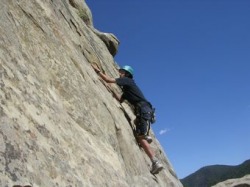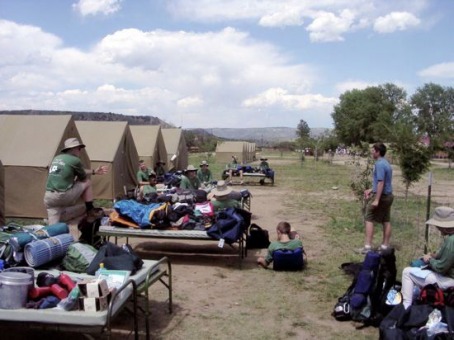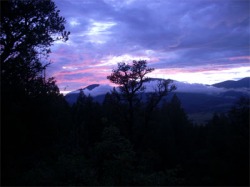Scheduled Training and Meeting Dates
Final Training dates will be set by the Crew going to Philmont.
These will be posted soon.
These will be posted soon.
- August 24, 2010- 6:15 PM: Parent /Scout Information Meeting at Viking Park (Just prior to scout Meeting)
- TBD: Crew organizational meeting
- TBD: Training hike - Penasquitos Canyon
- TBD: Eqjuiment Check
- TBD: Training Hike - Iron Mountain
- TBD: Crew Backpack Training
- TBD: Crew organizational meeting
- TBD: Training Hike - Cowles Mountain
- TBD: Team-Buiilding - Mira Mesa area
- TBD: Training Hike - Mount Woodson
- TBD: Training Hike - Pacific Coast Trail
- TBD: Crew organizational meeting - trek planning
Philmont Trekking

Introduction
Whenever you walk around base camp at Philmont Scout Ranch during the summer you will see the "cripples": Boy Scouts, mostly adult leaders, who have broken down on the trail and had to be removed from their crew and evacuated from the backcountry. They are almost always limping but quite often you will find them hobbling around with crutches. For each one you see in the base camp there are many more on the trails that are just barely making it and regretting their decision to come to Philmont. Why is this happening when Philmont is one of the great adventures in Scouting? The two most common errors are insufficient training and carrying too much weight. When these two errors happen simultaneously that person has created a dangerous situation for himself, and his crew.
Philmont publishes a pamphlet, Philmont Guidebook to Adventure, which gives Scouts information on the Philmont experience, the training, and equipment needed to hike its trails. The equipment list is extensive (read "heavy"), with lots of gear and multiple sets of clothing. Most people who read this pamphlet assume that this is the recommended list of equipment to bring to Philmont. It is not! There is one paragraph in this pamphlet that is the key to your success at Philmont that most people miss:
Photo: Rock climbing at Cow Camp, Philmont 2004.
Courtesy of Larry Keil, ASM, Troop 815, Danville, CA
Whenever you walk around base camp at Philmont Scout Ranch during the summer you will see the "cripples": Boy Scouts, mostly adult leaders, who have broken down on the trail and had to be removed from their crew and evacuated from the backcountry. They are almost always limping but quite often you will find them hobbling around with crutches. For each one you see in the base camp there are many more on the trails that are just barely making it and regretting their decision to come to Philmont. Why is this happening when Philmont is one of the great adventures in Scouting? The two most common errors are insufficient training and carrying too much weight. When these two errors happen simultaneously that person has created a dangerous situation for himself, and his crew.
Philmont publishes a pamphlet, Philmont Guidebook to Adventure, which gives Scouts information on the Philmont experience, the training, and equipment needed to hike its trails. The equipment list is extensive (read "heavy"), with lots of gear and multiple sets of clothing. Most people who read this pamphlet assume that this is the recommended list of equipment to bring to Philmont. It is not! There is one paragraph in this pamphlet that is the key to your success at Philmont that most people miss:
Photo: Rock climbing at Cow Camp, Philmont 2004.
Courtesy of Larry Keil, ASM, Troop 815, Danville, CA
Gathering Your Equipment

Backpacking requires proper equipment just as any outdoor sport. Without suitable equipment you will face unnecessary hardships. Take only what you need. After several overnight camps you should be able to conduct your own shakedown to eliminate items you didn't need. Remember, the key to successful backpacking is to go lightly. Check your equipment against the recommended lists on page 12 and 13. This is the maximum. All backpackers can reduce this list and still be comfortable, clean, and safe.
Philmont Guidebook to Adventure 2002, 2003, 2005 and 2006
Photo: Equipment check on day one, Philmont 2004.
Courtesy of Larry Keil, ASM, Troop 815, Danville, CA
The above paragraph sounds like something Ray Jardine wrote instead of the Boy Scouts of America. Statements like "take only what you need," "eliminate items you don't need," and "the key to successful backpacking is to go lightly" have been heard for years throughout the lightweight backpacking community.
This article will show you a reasonable list of gear and techniques that will allow you to carry a lighter pack and truly enjoy the wonders Philmont has to offer.
When I asked my 18-year-old son (Philmont trek 2002, Rayado 2003) how others or I could lighten our packs, his immediate response was, "Bring your 18-year-old son and give him all your gear." He was joking, of course, but there's a lot of wisdom in this statement. At Philmont you function as a "crew" or team. You succeed or fail as this team. If you have immensely strong Scouts they can and should carry more of the group gear than the weaker ones, whether boys or leaders. This allows the whole crew to move the most efficiently around Philmont.
Philmont assigns a Ranger to your crew for the intake process and to hike with you for a few days. The Ranger will get your crew through the intake process, ensure that you bring the appropriate gear, and train the crew on Philmont techniques. Your particular Ranger is the one you need to convince concerning the clothing and equipment you bring. Many people who frequent Backpacking Light will know a bit more about backpacking than your average 18-22 year old Ranger, but please do not harass them. Just take the time to explain yourself and your choices and most of the time they will go along with your choices. I recommend that you not challenge them on anything to do with bear protection. In 2002 we wanted to bring lighter ropes and bags, but our Ranger disagreed. We took the Philmont ropes and bags. In 2005 we had a similar event. I cannot see them approving the Bozeman Mountain Works AirCore Pro URSA Dyneema Bear Bag Hanging Rope even though it may be a better and lighter choice.
Philmont does a really good job of having thousands of Scouts camping in close proximity to lots of bears with very few problems and needs to be congratulated for their efforts to keep everyone safe.
Context
The gear on the list below was selected specifically to meet the requirements of Philmont Scout Ranch while being as light as possible. Although the list was compiled for Boy Scouts and Scout Leaders attending Philmont, it will work equally well for others interested in a lighter pack.
Seasons: Summer - lows to the 40s F, high 80s to 90s F, short afternoon showers common
Length: Four days between resupply
Where: Philmont Scout Ranch, Sangre de Cristo mountains, New Mexico
Philmont Guidebook to Adventure 2002, 2003, 2005 and 2006
Photo: Equipment check on day one, Philmont 2004.
Courtesy of Larry Keil, ASM, Troop 815, Danville, CA
The above paragraph sounds like something Ray Jardine wrote instead of the Boy Scouts of America. Statements like "take only what you need," "eliminate items you don't need," and "the key to successful backpacking is to go lightly" have been heard for years throughout the lightweight backpacking community.
This article will show you a reasonable list of gear and techniques that will allow you to carry a lighter pack and truly enjoy the wonders Philmont has to offer.
When I asked my 18-year-old son (Philmont trek 2002, Rayado 2003) how others or I could lighten our packs, his immediate response was, "Bring your 18-year-old son and give him all your gear." He was joking, of course, but there's a lot of wisdom in this statement. At Philmont you function as a "crew" or team. You succeed or fail as this team. If you have immensely strong Scouts they can and should carry more of the group gear than the weaker ones, whether boys or leaders. This allows the whole crew to move the most efficiently around Philmont.
Philmont assigns a Ranger to your crew for the intake process and to hike with you for a few days. The Ranger will get your crew through the intake process, ensure that you bring the appropriate gear, and train the crew on Philmont techniques. Your particular Ranger is the one you need to convince concerning the clothing and equipment you bring. Many people who frequent Backpacking Light will know a bit more about backpacking than your average 18-22 year old Ranger, but please do not harass them. Just take the time to explain yourself and your choices and most of the time they will go along with your choices. I recommend that you not challenge them on anything to do with bear protection. In 2002 we wanted to bring lighter ropes and bags, but our Ranger disagreed. We took the Philmont ropes and bags. In 2005 we had a similar event. I cannot see them approving the Bozeman Mountain Works AirCore Pro URSA Dyneema Bear Bag Hanging Rope even though it may be a better and lighter choice.
Philmont does a really good job of having thousands of Scouts camping in close proximity to lots of bears with very few problems and needs to be congratulated for their efforts to keep everyone safe.
Context
The gear on the list below was selected specifically to meet the requirements of Philmont Scout Ranch while being as light as possible. Although the list was compiled for Boy Scouts and Scout Leaders attending Philmont, it will work equally well for others interested in a lighter pack.
Seasons: Summer - lows to the 40s F, high 80s to 90s F, short afternoon showers common
Length: Four days between resupply
Where: Philmont Scout Ranch, Sangre de Cristo mountains, New Mexico
More on Planning.....

You will be able to find more information on Trek planning at this web site: http://www.backpackinglight.com/cgi-bin/backpackinglight/philmont.html
